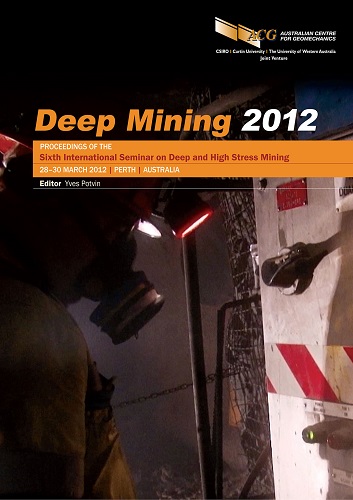Performance of dynamic support system in highly burstprone ground conditions at Vale’s Copper Cliff Mine ‒ a case study

|
Authors: Chinnasane, DR; Yao, M; Landry, D; Paradis‐Sokoloski, P |
DOI https://doi.org/10.36487/ACG_rep/1201_04_chinnasane
Cite As:
Chinnasane, DR, Yao, M, Landry, D & Paradis‐Sokoloski, P 2012, 'Performance of dynamic support system in highly burstprone ground conditions at Vale’s Copper Cliff Mine ‒ a case study', in Y Potvin (ed.), Deep Mining 2012: Proceedings of the Sixth International Seminar on Deep and High Stress Mining, Australian Centre for Geomechanics, Perth, pp. 57-69, https://doi.org/10.36487/ACG_rep/1201_04_chinnasane
Abstract:
Mining in the 100/900 orebodies (OB) at Copper Cliff Mine in the Sudbury Basin has been associated with significant seismic activity. In September 2008, a 3.8 magnitude event occurred in the middle 100/900 OB and caused considerable damage to various excavations on multiple levels. Approximately 3,000 t of material were displaced in total and the damage was spread over a 300 m vertical block between 2700 and 3710 L. An analysis of the rockburst incident revealed that the previously installed support system was inadequate to withstand the impact of the dynamic load caused by the 3.8 Nuttli magnitude (Mn) seismic event. In view of this, a decision was taken to identify the areas prone to bursting, so that a burst-resistant support system could be employed, which would help minimise damage in the case of future occurrences. Accordingly, a rating system was developed to identify the areas that are prone to bursting conditions and Vale employed burst-resistant support system in all such identified areas. After introducing the burst-resistant support system at Copper Cliff Mine, mining in the 100/900 OB was resumed. With the resumption of mining in the 100/900 OB, the Copper Cliff Mine started to experience an elevated seismic activity with a number of large seismic events ranging from 1.2 to 2.9 Mn events. Four stopes were mined out successfully without any significant damage after introducing the burst-resistant support system in the burst-prone areas at Copper Cliff Mine. This paper presents a case study which outlines the performance of the dynamic support system while mining the stopes that were located in the vicinity of highly burst-prone ground conditions.
References:
Gaudreau, D., Aubertin, M. and Simon, R. (2004) Performance of tendon support systems submitted to dynamic loading, in Proceedings Fifth International Symposium on Ground Support, Ground Support in Mining and Underground Construction, E. Villaescusa and Y. Potvin (eds), 28–30 September 2004, Perth, Australia, Australian Centre for Geomechanics, Perth, pp. 299–312.
Kaiser, P.K., McCreath, D.R. and Tannant, D.D. (1996) Canadian Rockburst Support Handbook, Geomechanics Research Centre, MIRARCO Sudbury, Ontario, Canada.
McCreath, D.R. and Kaiser, P.K. (1992) Evaluation of current support practices in burst-prone ground and preliminary guidelines for Canadian hardrock mines, in Proceedings International Symposium on Rock Support in Mining and Underground Construction, A.A. Balkema, Rotterdam, pp. 611–619.
Yao, M., Chinnasane, D.R. and Harding, D. (2009) Mitigation Plans for Mining in Highly Burst-Prone Conditions at Vale Inco Copper Cliff North Mine, ROCKENG09: Proceedings of the 3rd CANUS Rock Mechanics Symposium, Toronto, May 2009, M. Diederichs and G. Grasselli (eds).
© Copyright 2025, Australian Centre for Geomechanics (ACG), The University of Western Australia. All rights reserved.
View copyright/legal information
Please direct any queries or error reports to repository-acg@uwa.edu.au
View copyright/legal information
Please direct any queries or error reports to repository-acg@uwa.edu.au